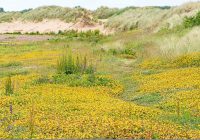Dr Phil Smith’s Wildlife Notes
June 2019
After one of the driest winters and springs in living memory, twelve days with measurable rain in June were riches indeed. While some parts of the country were flooded, we had just enough to reverse earlier drought conditions. There was even some late spawning by Natterjack Toads, though the tadpoles are unlikely to complete their development. The extent to which our wildlife is impacted by weather condition was graphically illustrated. Rainfall in the first half of the month had a spectacular effect on the sand-dune flora with orchids appearing in fantastic abundance. Pyramidal and Bee Orchids were everywhere. Joshua Styles reported driving past Bee Orchids on a Southport roundabout, so Trevor Davenport and I braved the traffic to count a remarkable 210 flower-spikes. Green Sefton’s John Dempsey arranged for mowing to be delayed so they could set seed. Ironically, however, a letter to the local newspaper complained about grass being uncut on a roundabout – you can’t please everyone!
Marsh-orchids also responded to the conditions, with nearly over 1900 Southern, Northern and Early Marsh-orchids being counted at ponds off Range Lane, Formby; a 30% increase on last year’s total. Pete Kinsella reported the reappearance of a rare white form of the Early Marsh-orchid in a slack north of Sands Lake, so I went to see it with Patricia Lockwood on 22nd. It did not disappoint, an additional attraction being several enormous Southern Marsh-orchids nearby. Dune ridges to the west supported hundreds of Pyramidal and Bee Orchids but also an infestation of Broad-leaved Everlasting-pea, a garden-escape that is giving rise to increasing concern because of its rapid spread.
A visit to Hightown dunes with Trevor Davenport was rewarded by impressive stands of Viper’s Bugloss, a plant not much seen elsewhere on the Sefton Coast. As usual, their handsome blue spikes attracted several Narrow-bordered Five-spot Burnet moths. At the famous shingle beach formed from eroded brick-rubble, we were overwhelmed by the golden sheets of Kidney-vetch, together with many large plants of Yellow-horned Poppy and other shingle specialists. As Trevor remarked, “You couldn’t grow a garden like this!”
Another botanical surprise came on 25th when I joined Joshua Styles at Freshfield Dune Heath Nature Reserve for one of his reintroduction projects under the North West Rare Plant Initiative. Having spread seed of the locally extinct Small Cudweed, I could hardly believe my eyes when I looked down to see three patches of Annual Knawel, not a particularly attractive species but one that is listed in the GB and England Red Data Books as “Endangered” and whose only known population in the region is at Birkdale Common. It represents a welcome addition to this reserve’s rich flora, now totalling 363 higher plants.
Our duneland flora attracts enthusiasts from far and wide, including the nationally renowned Bradford Botany Group, 17 of whose members visited on 15th. Joshua Styles guided them round the Ainsdale area in the morning while Josh and I took them on the Green Beach in the afternoon. They were blown away by the variety of plants on view. As usual, they came up with a new plant for the coast, Chinese Mustard, a rather obscure crucifer, while Josh’s sharp eyes spotted an odd-looking grass on the Green Beach. It was later confirmed as a hybrid between Dune Fescue and Red Fescue, which rejoices in the name ×Festulpia hubbardii. It has been recorded here before but not for many years.
Early in the month, there were few summer butterflies and dragonflies around, perhaps a result of the 2018 drought last year or the unusual spring weather. However, their fortunes improved later, Meadow Browns, Small Skippers and Ringlets appearing in the last few days. There was also a major invasion of Painted Ladies. However, this paled into insignificance compared with June’s major wildlife event – an unprecedented influx of rare dragonflies. The first signs came on 26th when I was amazed to find two or three Red-veined Darters on a Natterjack Toad scrape at Hightown. Over the next few days, dozens of these colourful migrants from the south appeared at sites all along the coast. Even more remarkable was Pete Kinsella and Mark Nightingale’s sighting on 27th of up to four Vagrant Emperors, including a mating pair, at Ainsdale Sand Dunes National Nature Reserve. This was the first record for Merseyside of an insect that mainly breeds in semi-desert regions of Africa and Asia and, although still rare, is now appearing more often in Britain. I speculate that the pulse of hot air from the Sahara that broke temperature records in France pushed these dragonflies north ahead of it. More were reported at other British coastal locations. The old Hollywood favourite “You ain’t seen nothing yet” seems appropriate as several African dragonflies, now breeding in southern Europe, are on their way north and may yet reach us as climate change continues.





